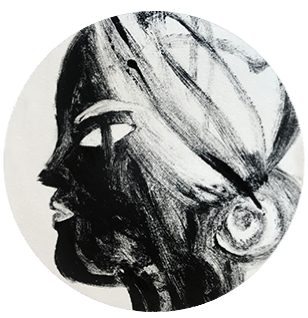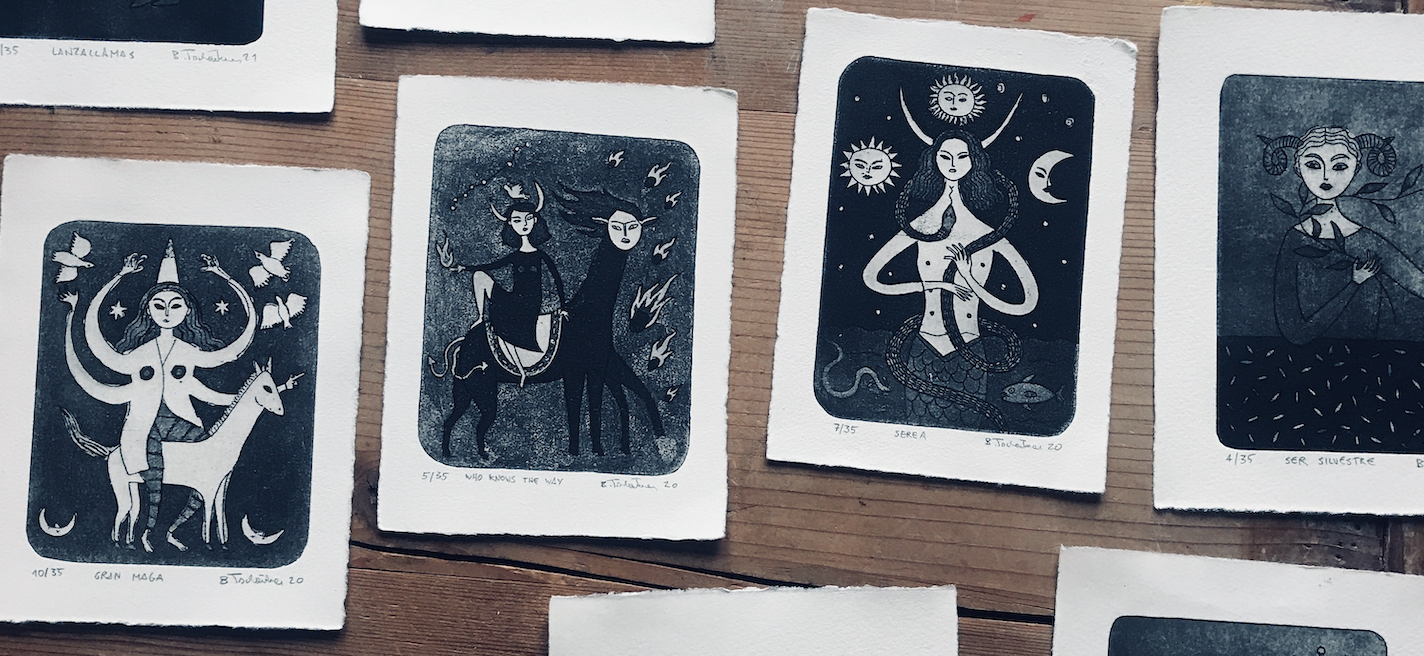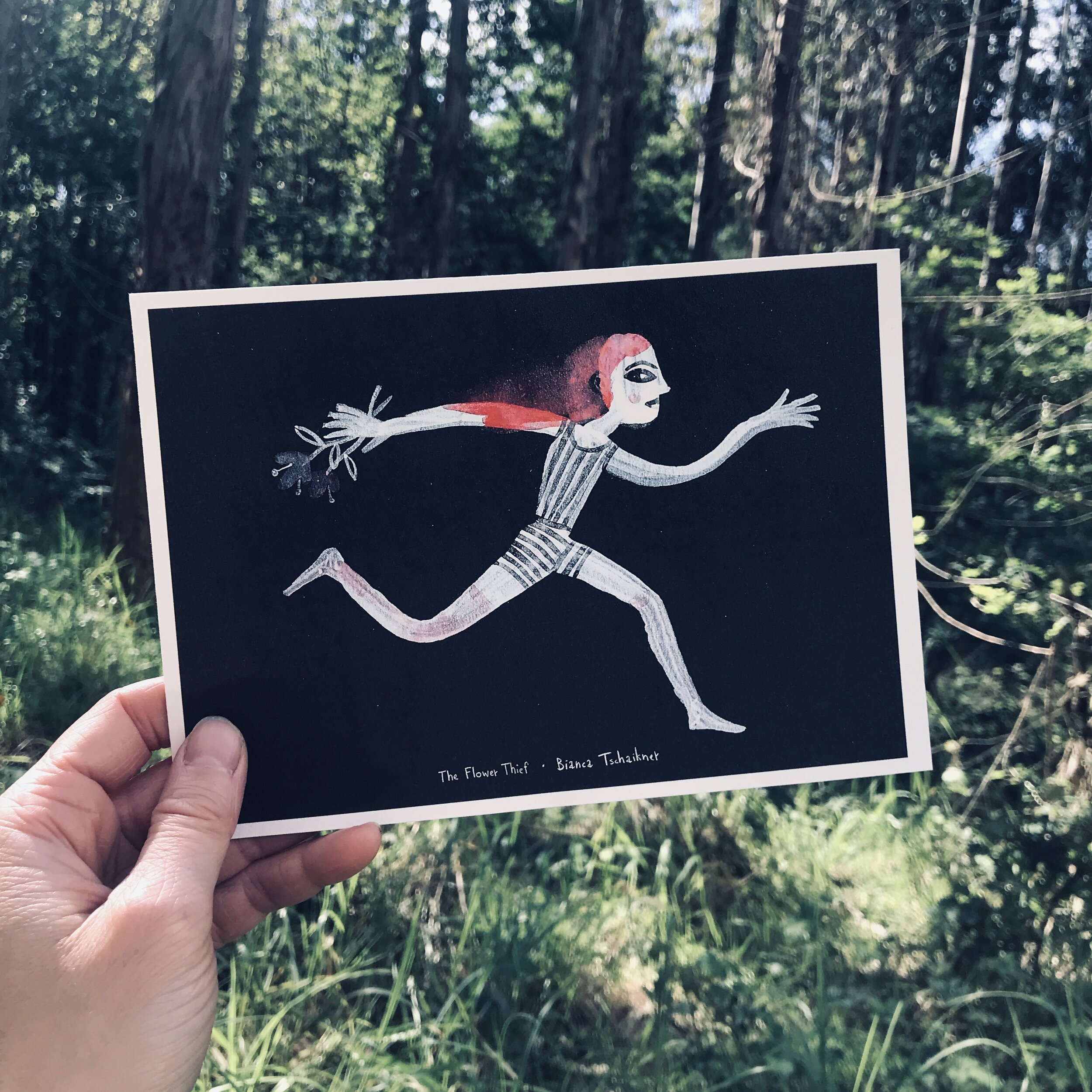(für den deutschen Text nach unten scrollen)
In 2018, I visited Pakistan for the first time. Arriving with a broken hand in a cast and not being able to paint, I concentrated on collecting stories. I was so fascinated with the storytelling culture I encountered there that I decided to return the following year. This time, I was invited to stay with a couple in Lahore, well-known intellectuals and both of them well beyond the age of retirement, but still working relentlessly, spending entire days out of the house, engaged in all sorts of cultural, artistic, and development work all over Pakistan.
On most days, they would only appear late at night, when we would meet around the kitchen table for dinner, delicious dishes served by their delightful maid with whom I could only communicate with wild gestures and smiles, and who I’m sure would also have had a lot of stories to tell, would we have had a common language to communicate with each other.
It was during these nights that the old couple told me the most fascinating stories about Pakistan, some of which were funny, some of which were sad – most of them were funny and tragic at the same time. So at night, I would listen to their stories, while I spent the mornings on the the rooftop, painting artworks inspired by these stories.
One of the most fascinating stories they told me was the story of Dappa.
Dappa is the secret and defiant oral poetry of Pakhtun women in Afghanistan and West Pakistan. It is practiced during daily tasks such as fetching water from the well and which (both women leaving the house for whatever task and practicing poetry) naturally did not delight the Taliban.
Some examples of Dappa are: You’re talking about the honor of your daughter, until the money jingles in your pocket, or When will you leave the house, old man, my lover is already waiting behind the door to kiss my rosy cheeks.
In one village, a Western NGO decided to “improve” the life of the people and install running water in each household. The result was that the women had no reason to go out anymore and had to stay at home (because god beware a woman walking around only for her own enjoyment), which naturally pleased the Taliban, but not the women, who complained with the NGO: You thought you were improving our lives, but you have destroyed our culture.
But there is a somewhat happy ending to the story of the women of this village: They found another place, where they could, undisturbed by the Taliban and other men, practice Dappa.
This and similar stories from Khyber Pakhtunkhwa I was told last year in Pakistan, where I made a series of paintings inspired by my stay, including this one. It’s a woman in traditional clothes with water pitchers painted with symbols alluding to themes of Dappa poetry. The word Dappa itself is an onomatopoeia, coming from the sound of the waterpots being rhythmically beaten to accompany the spoken word.
It is very dangerous to travel to KP, there is a lot of terrorism, and the risk of being kidnapped is extremely high for foreigners. In fall 2020, I would have had a safe opportunity to travel to KP and to collect Dappa verses, which I was extremely excited about. But then, the pandemic happened and I couldn’t go.
One day, roaming in the poetry section of a Muslim bookstore in Singapore, to my great delight, I discovered a little treasure called Songs of Love and War – a wonderful collection of Dappa verse gathered by an Afghan scholar and poet named Sayd Bahodine Majrouh, who was assassinated in Peshawar in the 80ies.
In Lahore, I had only heard poems about love – funny, tender and, given the cruel circumstances female life is subjected to in Pakhtun culture, deeply tragic. Majrouh collected poems from war refugees in refugee camps in Afghanistan. The Pakhtun people always have been warriors: The different tribes are always engaged in war, and this culture of violence obviously does not stop at the house door. Also in these circumstances that make every woman double victim, both of war and of domestic violence, she keeps her defiance, cleverly turning the tradition of the glorification of male violence against himself: Man, if you don’t win this war, don’t even bother come back home.
Her words become her weapons, they are her only weapons. This is the power of poetry, which is manifold and which here becomes a means of survival, a way to speak and live a woman’s truth, of retaining her dignity and sanity in a world of brutal and senseless male oppression and violence.
The water hole and the poetry that is practiced there becomes an oasis in a wasteland: Where there is poetry, there is hope. There exist thousands and thousands of these oases, in which a world that is not allowed to exist, but which has to exist, is created, recreated, through language – or rather, preserved.
Because it is not a new world that is described here, it is a world that has always existed, and always will, even though nowadays it’s an invisible world, hidden behind veils.
This world is the foundation of human existence, essential and precious, it’s the fertile soil underneath the stage on which the shadow theatre, that great drama, the tragicomedy of the male rule is being played.
And even though this hidden world is already and always present – in the oasis sleeps a great future. Its time, which will mean flourishing and revelation, has not come yet, but it will come. In the meantime, it’s blooming in the oases of hope, where it is being spelled out over and over, being evoked in the rhythm of the clapping of the hands, in the slower rhythm of the fetching of water, and finally in the great, all-embracing rhythm which underlies One day, the great drama of men, which feels like our past and our present and our future, but actually is nothing but a dark pause between two beats of the great drum, will end, the source of water will break open and flow into the desert, and flowers will bloom.
___________________________________________________________________
Mein Liebhaber wartet hinter der Tür: Gedichte, die die Taliban ärgern
Dappa ist die geheime, aufsässige Dichtkunst der Paschtuninnen in Pakistan und Afghanistan, die beim alltäglichen Wasserholen, eine der wenigen Tätigkeiten, für die Frauen das Haus verlassen dürfen, praktiziert wird und welche die Taliban naturgemäß wenig erfreut. Beispiel: Du redest von der Ehre deiner Tochter, bis das Geld in deinen Taschen klingelt. Oder: Wann gehst du endlich aus dem Haus, Alter, mein Liebhaber wartet bereits hinter der Tür, um mich auf meine rosigen Wangen zu küssen.
In einem Dorf kam es zu einer so unglücklichen wie unfreiwilligen Allianz einer westlichen NGO mit den Taliban, als erste beschloss, das Leben der Menschen zu “verbessern” und jedes Haus mit fließendem Wasser zu versorgen. Die tragische Nebenwirkung dieser Maßnahmen war, dass die Frauen keinen Grund mehr hatten, außer Haus zu gehen, und nun zuhause bei ihren Wasserhähnen bleiben mussten.
Die Taliban freuten diese Umstände naturgemäß, die Frauen weniger, und die NGO musste Schimpf und Schande über sich ergehen lassen: Ihr habt unsere Kultur zerstört!
Die Geschichte dieses Dorfes ging noch halbwegs gut aus, und die Frauen fanden letztendlich einen anderen Ort, wo sie ungestört von den Taliban und anderen Männern Dappa praktizieren konnten.
Diese und ähnliche Geschichten aus Khyber Pakhtunkhwa erzählte man mir letztes Jahr in Pakistan, wo ich dieses und andere Bilder, inspiriert von Geschichten aus Pakistan malte. Dieses Bild zeigt eine Frau in traditioneller Kleidung, auf ihrem Kopf stapeln sich die Wassertöpfe, die mit Symbolen bemalt sind, die an die Themen von Dappa hinweisen. Das Wort Dappa selber ist eine lautmalerische Nachbildung des mit den Händen auf die Wassertöpfe Schlagens, mit dem das gesprochene Wort mit Rhythmus unterlegt wird.
Letzten Herbst hätte sich mir sogar eine Möglichkeit eröffnet, mit einer Delegation in relativ sicherem Rahmen nach Khyber Pakhtunkhwa zu reisen (denn einfach so kann – oder will – man da nicht hin: Das Entführungsrisiko für AusländerInnen ist extrem hoch) und Dappa-Verse zu sammeln, ein Vorhaben, das leider durch die Pandemie verunmöglicht wurde.
Im Frühjahr 2020, kurz vor dem Ausbruch der Pandemie, fiel mir in der Lyrikabteilung einer muslimischen Buchhandlung in Singapur das Buch Songs of Love and War in die Hände – eine wunderbare Sammlung von Dappa-Versen eines afghanischen Gelehrten und Dichter namens Sayd Bahodine Majrouh, der in den Achtziger Jahren nach Peshawar, eine Grenzstadt zwischen Pakistan und Afghanistan, ins Exil ging und dort ermordet wurde. Die Gedichte, die man mir in Lahore erzählte, handelten von der Liebe, waren lustig, liebevoll, oft auch – angesichts der Umstände, unter denen paschtunische Frauen leben müssen – tragisch. Majrouh hingegen, sebst Paschtune, sammelte seine Gedichte in afghanischen Flüchtlingslagern. Die Paschtunen sind kriegerische Stämme, ihre Kultur ist seit jeher von Gewalt und Krieg geprägt. Die von Majrouh gesammelten Texte zeigen, neben der Lust und der Liebe, noch ein anderes, gewalttätige Gesicht einer Stammeskultur, die sich seit Jahrhunderten und Jahrtausenden in einem unaufhörlichen Krieg befindet, ein Krieg, der, naturgemäß, vor der eigenen Haustür nicht halt macht und stets als Dritter zwischen der Beziehung von Frau und Mann steht: Mann! Wenn du diesen Kampf verlierst, brauchst du gar nicht mehr nach Hause kommen.
Dieser Vers ist mir im Kopf geblieben: Er zeigt, dass selbst unter diesen Umständen, die die Frau zum doppelten Opfer der Gewalt machen, der sie als Frau sowohl drinnen und draußen ausgesetzt ist, sie im Geiste aufsässig bleibt und die Poesie dazu verwendet, die unheilbringende Tradition der Verherrlichung männlicher Gewalt und die Logik des Krieges, den er führt, gegen den Mann selbst zu richten. Er zeigt wohl aber auch, dass sie – wie könnte es anders sein – selbst in Logik des Krieges und der Gewalt gefangen ist.
Die Waffen einer Frau ist die Dichtung, das Wort – es sind ihre einzigen Waffen in diesem Krieg. Und hier zeigt sich die Macht der Poesie, die hier zu einer Überlebensstrategie wird. Die Dichtung bietet einen Raum, in dem eine Frau – gemeinsam mit anderen Frauen – ihre Wahrheit aussprechen, leben und sich ihrer immer wieder vergewissern kann, in der sie sein kann, was sie ist: Die Poesie ist die einzige Möglichkeit, ihre Würde und Eigenständigkeit gegenüber dem Mann, und sei es nur in ihrem Innersten, zu bewahren und so ihren Verstand nicht zu verlieren in einer Welt der brutalen und sinnlosen männlichen Unterdrückung und Gewalt.
Das Dichten an der Wasserstelle wird zu einer Oase in einer wüsten Welt: Wo gedichtet wird, gibt es Hoffnung. Abertausende gibt es von diesen Oasen, in denen eine Welt, die nicht existieren darf, aber existieren muss, durch Sprache geschaffen, oder vielmehr bewahrt wird. Denn es ist keinen neue Welt, die da beschrieben wird, sie hat immer schon existiert, wenn auch heute heimlich und unsichtbar, hinter Schleiern. Sie ist die notwendige Grundlage allen menschlichen Seins, das Essentielle, die fruchtbare Erde unter der wackeligen Bühne, auf dem das Schattentheater, die großen Inszenierung, die Tragikomödie der Männerherrschaft gespielt wird. Und trotz ihrer Allgegenwärtigkeit schläft in ihr auch eine große Zukunft: Ihre Zeit, die Blüte und Offenbarung bedeuten wird, ist noch nicht gekommen, aber sie wird kommen. In der Zwischenzeit blüht sie in den Oasen der Hoffnung, wo sie beschrieben wird und ausgesprochen, wo sie immer wieder evoziert wird, im schnellen Rhythmus der Worte und dem Klatschen der Hände, im langsameren Rhythmus des Wasserholens und schließlich im größten, allumfassenden Rhythmus, der alles bestimmt: Eines Tages wird die große Inszenierung der Männer, die gefühlt ewig dauert, aber in Wahrheit nichts anderes ist als die Pause zwischen zwei Trommelschlägen, enden, die Wasserquelle wird aufbrechen und ungehindert in die Wüste fließen, und die Blumen werden wieder blühen.





